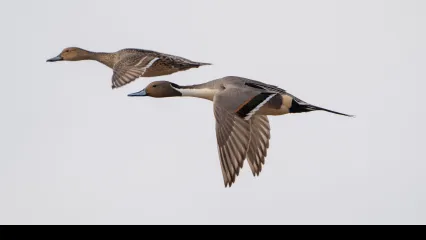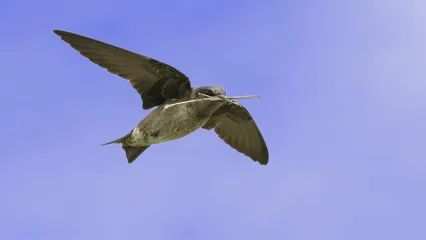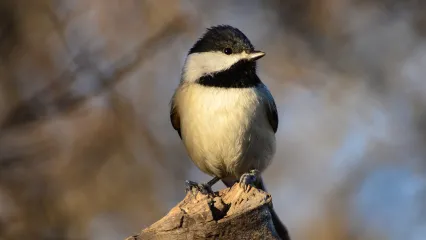
Description
A member of the dabbling duck family, the northern pintail's name, as well as its scientific name (Anas acuta), "points" at this bird's key characteristic - its elongated and pointed tail feathers. The northern pintail has many unique features that make it a spectacular bird to see during the winter season in Oklahoma. Given the nickname, "greyhound of the air," the northern pintail is a very athletic and acrobatic bird. It is able to achieve impressive speeds while flying. A large and slender body, elongated neck, and long and narrow wings make this bird the master of the airways. As in most ducks, pintail males and females have different plumages, with the male being the more distinct and vibrant of the two.
One of the most handsome of ducks, the male pintail has a very striking appearance during the breeding season. He is known for his chocolate brown head, white neck and undercarriage, grey and black dorsum, bluish-grey bill, dark brown eyes, grey legs, and elongated black tail feathers. The eclipse or non-breeding male looks similar to the female's year-round plumage, consisting of a duller and overall-brownish color, but retaining the upper-wing pattern and grey shoulder feathers.
Best identified in flight, the female pintail shows off her elongated neck and slender body. Even though the tail feathers are much shorter than the male's, the female still has the characteristic pointed tail. The female's plumage consists of a tan head and neck, mottled brown dorsum, and white belly. Like the male, she also has a bluish-grey bill, grey legs, and dark brown eyes. While the drake has an iridescent green speculum, the female's speculum is brown, but both have a thin white trailing edge.
The pintail is a very unique dabbling duck. This duck's distinctive long neck allows it to feed on the bottom of shallow waters, up to one foot deep, which is beyond the reach of other ducks in this family. The pintail, like all ducks, is omnivorous and will eat a wide variety of foods. The winter diet includes seeds, grains, aquatic plants, grasses, and algae, while they feed mainly on aquatic insects, crustaceans, snails, and small fish during the breeding season.
Among North America's duck species, the northern pintail's population has seen the most significant decline since the 1950s due to habitat loss. Much of the pintail's breeding grounds, including the Prairie Pothole Region, are disappearing and being destroyed due to the increase in agriculture. Drought and avian diseases have also played a major role in this duck's population decline.
Fortunately, there has been much effort over the past few decades in trying to reverse the pintail's declining population trend. Restoring and protecting the habitat the pintail uses for breeding is a key element in helping this species repopulate. Since the northern pintail is a North American game bird, there are regulations on hunting this duck. Oklahoma allows a daily limit of pin tail to be harvested. With the help of hunters and conservationists, the goal is to see the northern pintail's population reverse its downward trend so that we can continue to enjoy the presence of this duck.
Habitat
The northern pintail is a northern hemisphere bird that has a very wide geographic range, including North America, Europe and Asia. Since it is a migratory duck, the pintail spends its year in two places -the breeding and wintering grounds.
In North America, pintails breed from Alaska and central Canadian Arctic and south to the northwest and north-central United States. The pintail favors open lowland grasslands and wetlands found in prairie and tundra habitats. The Prairie Pothole Region is one of the primary breeding grounds of the pintail. It consists of depression wetlands and freshwater marshes that are found in southern Canada to the northern Great Plains.
Oklahoma is one of the many places that the pintail inhabits during its wintering period. It is one of the first ducks to migrate south in the fall, which starts as early as mid-August after both sexes have undergone their molt. Most of the pin tails that spend their winter in Oklahoma usually migrate from the Prairie Pothole Region. Upon reaching their wintering grounds, pintails, very gregarious in nature, group in large concentrations in freshwater habitats. Being the first to arrive, they are also one of the first to leave to return to their breeding grounds.
Life Cycle
The northern pintail breeds from April to June mostly in solitary pairs. The nest consists of a hollow in the ground that is lined with down and grass. Surrounded by plenty of vegetation, the nest is usually constructed away from water, unlike most ducks. The female lays around 8 eggs, which hatch after 22-24 days of incubation. The male is the first to leave the breeding site to undergo his molt before reaching the wintering grounds. However, the female stays with the young and undergoes her molt and then follows a few weeks later to the wintering grounds.


